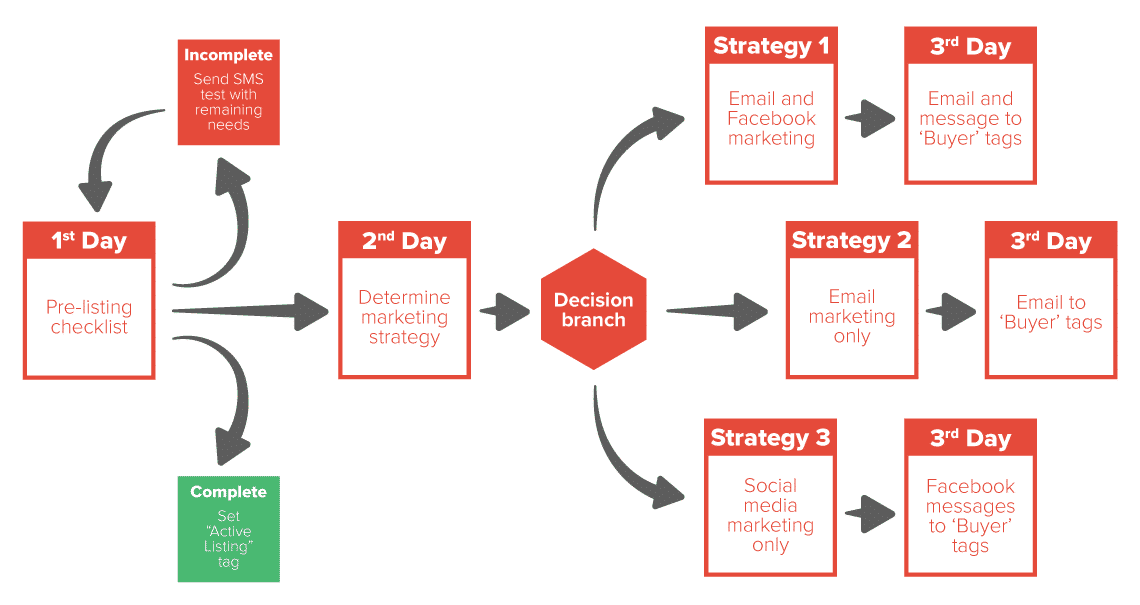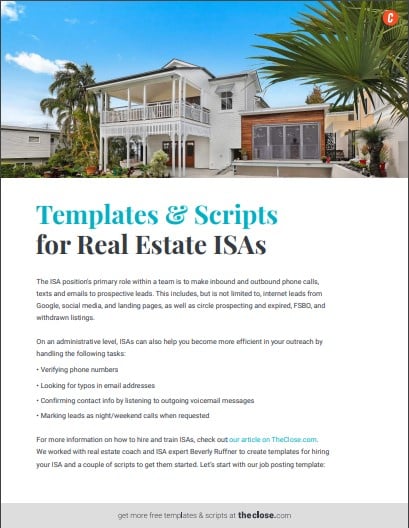Why do inside sales agents, or ISAs, get such a bad rap in the real estate industry? Is it the failed expectation of not getting enough qualified appointments? Is it the leads, or is it the market? Do real estate ISAs need better scripts? Or maybe they’re just not a fit for the job?
These are all of the questions that go through the mind of anyone who has hired or is looking to hire for the ISA position. I can certainly claim “guilty” to all the above situations. Seems easy enough, right? Just call all these numbers and get me appointments! However, it really is not that easy.
Unfortunately, there is no real how-to guide for this position. What I can tell you is that this approach—“Here’s the login to my CRM. I know there’s gold in there; now just start calling and get me some appointments!”—will end in disaster.
Now that we know what not to do, let’s get you hiring and training. I have 10 years of experience hiring, training, and working with ISAs, which is why my tips, templates, and scripts will fast-track you for success.
But before we get into my training guide, let’s talk about what inside sales agents can do for your real estate business and why you might want to hire one.
What Is an ISA for Real Estate?
The ISA position’s primary role within a team is to make inbound and outbound phone calls and send texts and emails to prospective leads. This includes, but is not limited to, internet leads from Google, social media, and landing pages, as well as circle prospecting and expired, FSBO, and withdrawn listings.
In my opinion, the acronym “ISA” has been one of the biggest controversies in the real estate industry since online lead generation began. The unfortunate problem with this position has traditionally been the way most agents treat it. Instead of seeing ISAs as a primary source of business, they’ll hire a friend or family member who needs some extra cash who is ready, willing, and able to make phone calls. Agents also often fail to put any proper training or systems in place.
15 Reasons Your Leads Aren’t Calling You Back (+ Scripts & Solutions)
ISA Hiring Guide for Real Estate
When to Hire an ISA for Your Real Estate Business
I often see agents who are thinking about hiring an ISA fall into two different categories:
- Agents who have a ton of leads, but need help converting them into appointments and clients
- Real estate professionals who are building a team and looking to take their business to the next level
This makes the real question, “How can I best leverage my business to maximize my profits?” My years of ISA training experience have shown me that the majority of agents just want to throw money at positions because they think they don’t have the time to nurture leads.
But the honest truth here is that they just don’t want to do it and use time as an excuse. If you want real results, you must have systems in place to set the position up for success. The person in the “calling leads” position can truly take you to the next level, but you have to take time and be diligent about following the steps I have outlined below.
ISA Job Posting Template
Your goal with your ad for the open position of ISA in your real estate business should be designed to attract the right person for the job. Not chase them. Here’s an ad that does just that! I use this template for all my ISA hires.
INSIDE SALES POSITION- {location/remote}
Are you an overachiever? Are you looking for a ground-floor opportunity where your hard work and effort is rewarded in both compensation and knowing you are providing services that are proven to change lives? Are you looking for a company that challenges you to learn and grow? Do you want to be excited every day when you wake up, looking forward to doing something you know you can help, and more importantly, believing in what you are doing and being proud to be on the team?
Our company will challenge you to acquire more knowledge. You will be held to the highest level of integrity, be expected to work with a sense of urgency, and become an expert in our field of work, our services, and our proven methodology. As you grow with our company, you will see more opportunities unfold before your eyes. You will be a part of something that matters. And most of all, you will have fun because—as steadfast as we are in changing our industry—we are equally committed to a culture that rivals Google and Zappos.
We are looking for winners. We will help you win bigger. We aren’t looking for someone to just fill a seat and make some calls. We are hiring one key salesperson who meets our requirements, and we will invest in making sure you have all the tools and resources you need to achieve your personal goals within our company. We won’t waste your time, so please don’t waste our time if this opportunity doesn’t resonate with you at your core. We are the leader in the real estate industry, and we only hire top producers.
Young or old, if you have the stuff, we’ll know.
To apply: To be considered for this position, send a resume to {company email} with your salary requirements. Please use as your subject line: INSIDE SALES NEEDED. Resumes without salary requirements and this subject line will not be considered.
Location: {area}
- Principals only. Recruiters, please don’t contact this job poster.
- Please, no phone calls about this job!
- Please do not contact job poster about other services, products, or commercial interests.
💡 Pro tip: Pay particular attention to the “to apply” section. This was designed to see if the applicant has attention to detail, can follow simple instructions, and cares enough to meet your requests. This weeds out a lot and saves you interviewing time.
Finding the Right Person for the Job
After years of hiring for multiple positions within the real estate industry, it has become apparent to me that personality is everything. If you have ever taken a DiSC assessment, you’ll know it’s an invaluable asset for hiring for an ISA position.
First and foremost, you are looking for a people person. Here are a few things to look for in the interview process:
ISA Interviewing Tips
To find the right person, you have to ask the right questions. Also, I strongly suggest interviewing more than one person. This will help you be able to get a perspective of what you are looking for and what you are not looking for.
First Interview
We discussed above the importance of personality and getting to know if they are a team player or more of an independent. This first chat is a get-to-know-you interview, not a decision interview.
Let’s call this the discovery interview. Find out their expectations in terms of hours and pay. Is it in alignment with what your needs are? Are they a fit with your mission statement and core values? Let them know what to expect if they are called for a second interview, and that you have other candidates and you will be getting back to them.
Finally, leave them with homework. Ask them to please email you at their earliest convenience with the subject line of, “Why I am the perfect candidate for this position.” Ask them to tell you why they feel this way in the body of the email. This encourages positive thinking and shows the atmosphere you are creating.
💡 Pro tip: if you don’t have your mission statement and core values written out, do so, as it is necessary for the hiring process. Core values are what you hire, train, and fire to.
Second Interview
At this point, you can test how the candidate might perform in the role. Here’s how:
- Review your questions and scripts with the candidate, explaining the objective of each one. Give examples of a few objection scenarios and ask them how they would respond to these objections. You are not role-playing yet. This is just getting their mind into the right state, the warm-up.
- I suggest a minimum of five different role-play scenarios. Take turns being an ISA and an agent. Be gentle—they may have never done this before. You’re looking for creativity, their quickness to respond to objections with questions, and their ability to be coached. We are not looking for perfection—remember, you are training that.
- Have them make a few calls to old leads. Give them the opening line. For a buyer lead, it should be as simple as, “Hello, this is {name}. A while ago you were looking at homes online, and I am just checking in to see if you have made a purchase yet, or if you are still in the market.” For a seller lead, say, “Hello, this is {name}. A while ago you were thinking about selling your home. I was just wondering if you have sold or have you decided to stay.”
- Ask them to rate themselves on how they did with the role-play and the calls, as well as how they are feeling about it.
- At this point you should know if they are a go or a no.
But if all this seems like too much work, you might consider outsourcing this to an ISA company like Real Qualified. They’ll take over the job of qualifying and nurturing existing leads for you.
Training & Systems to Set Up Your Real Estate ISA for Success
Now that we have talked about the perfect hire, let’s move on to efficiency and creating proper systems to train to. The goal is to work smarter, not harder, right? Paying specific attention to details not only saves time, but it customizes the experience for the lead and increases the chances for conversion.
💡 Pro tip: Everyone has been drilled on the importance of speed to lead. Speed to lead is important, but it is more important to be consistent with attempts to connect. The benefit of having an ISA is they give you the ability to continue attempts, which gives you the edge.
Set Up Automated Call Filters in Your CRM
Building call filters in your customer relationship manager (CRM) of choice can help gamify cold calling for your ISAs and keep them engaged in the task on hand. Instead of focusing on how many leads need to be called, your new ISA can see it as the process of elimination. After all, who likes to paint a fence and look at how many more pickets still need to be painted? It’s much more rewarding to see how much progress has been accomplished.
If you’re not sure where to start, here are four main priority call lists (which you can make into CRM filters) that should be a priority for efficiency.
1. New Buyer & Seller Leads
These are the newest leads that have no attempted calls yet. Create a filter just for these leads. It is easiest if you can put them into a “new” status—that way, they are designated as fresh and easily recognized.
2. Leads Registered in the Last 14 Days That You Have Not Reached Yet
Keep leads you have never spoken to in an “attempting contact” status to separate them from the new leads and those you have already spoken to. The filter should consist of:
- Buyer leads who have registered in the last 14 days
- Listings that have expired or withdrawn in the last 14 days
- Valid or unknown phone numbers
Set your CRM up so that leads automatically fall out of this filter after the 14th day of coming into your CRM or when the ISA moves the lead status to “contacted.” As the new leads are coming in, your filter should always be moving out with the old and in with the new. The more conversations you are having, the smaller this list becomes. You should set and reward goals of a minimum of six to eight call attempts within the first 14 days for your ISAs. Talk about motivation to have conversations!
💡 Pro tip: Have your ISA make call attempts at different times of day to increase chances of connecting. Fluctuate from mornings to afternoons to evenings with no particular order. Continually changing up call times will maximize chances of connecting with a lead.
3. Active Leads
This is one of my favorite filters because older leads you have not spoken to who decide to start looking at homes again automatically fall in this filter. If they have been dormant from looking and all of a sudden start again, don’t you want to know?
This filter should consist of:
- Leads registered 15 or more days ago
- Leads active within the last 30 days
- Leads need to be in a status of attempting contact
- Valid or unknown phone number
They will fall out of this filter if you move the status to anything other than the status it was in or if they have not been active within the last 30 days. These leads should be called every seven days, at different times each attempt.
Just note that you’ll need an IDX website with an integrated CRM like Propertybase in order to know when your old lead becomes active again on your website.
4. Inactive Leads
These are the leads that have not been actively looking at homes or logged in for 31 or more days. These leads are moving further down the priority call list because by now they should have had a minimum of six to eight phone calls at different times. This list should consist of:
- Lead active 31 days to 5,000 days
- Lead needs to be in a status of attempting contact
- Valid or unknown phone number
As you probably already know, this is going to be the majority of your database. Remember these are all leads you have never spoken to. They do not need any reminders or extra attention.
You could technically break this list of leads out into months of inactivity if it is too large. For example, inactive 31-120 days, inactive 121-180 days, and so on.
These leads should initially be called monthly, and the longer they go inactive, the less often they need a call. This is where mass texting or emailing is great to get them to raise their hand without taking up too much of your ISA’s time.
💡 Pro tip: Set seller leads up on a neighborhood watch list to receive notifications of what is selling and coming on the market in their area. If they open emails, this will prioritize the lead quality. This is also great for branding.
Create a Detailed ISA Training & Best Practices Manual
Do you want to attract quality talent? Do you want to get high-level results? Then you need to always remember that the system is only as good as the person who designed it. It is great to have effective systems in place, but that system needs to be built from experience and managed. The more organized you are, the more organized your ISA will be and the more they will convert. It’s as simple as that!
Having proper guidelines spelled out in a training manual will ensure everyone on the team works the system in the same way. This way, it’s much easier to figure out if you have people problems or system problems. With any improvement to the system, you should see results from every single ISA on your team. If you don’t, you likely have a people problem and not a systems problem.
Is Your Business Ready for a Mack Truck?
One thing I always tell my coaching clients is to treat their business as if they’re going to be hit by a Mack truck tomorrow. Could your business or company run itself if something happened to you? If the answer is no, you better get busy with systems and best practices. A comprehensive training manual should mean your business can run smoothly with or without you there.
A Comprehensive Training Manual Makes Accountability Easier
Before I had my systems and training manual in place, it would weigh on me heavily when I hired an ISA that disappointed me. My first thought was to just fire them. But I always had to pause before firing them because I knew it was mostly my fault for not setting expectations or explaining my values. Of course they weren’t accountable, because I never set concrete expectations for them!
When I finally had systems in place and in writing, they would actually know exactly why and how they weren’t meeting expectations and what they needed to improve. That awful confusion and guilt of having to fire an ISA for what were essentially my own shortcomings as a manager was eliminated.
The amazing thing is that best practices are nothing more than a written manual of how-tos. We love to overcomplicate this process by overthinking everything, but what could be simpler than making a record of everything you do? Write down your steps of the process, make it a video tutorial, give it to your ISA, and voilà, you have a manual of best practices that will keep your ISAs accountable and on the path to success. So why do so many team leaders not do it?!
REDX Review: Pricing, Features, Pros & Cons
Nurturing Scripts to Make Lead Conversion Easy
After years of coaching ISAs and agents, I have heard variations of this next question nearly every day: What do I say when I follow up?
This is actually a surprisingly complicated question, but I am going to keep it simple. Stop overthinking what to say and focus on having your ISAs ask questions instead. Remember, she who asks the questions controls the conversation!
Asking the right questions helps keep the ISA on track with getting the right information. It also lets the lead feel more confident in the conversation because your ISA is asking them questions and letting them talk. Who doesn’t love to talk about themselves?
In my opinion, scripts are good for reference, but not a one-size-fits-all solution. That’s because they sound too … well, scripted. The lead can tell. Tell your ISA to focus on having a conversation like they are talking to their best friend about buying or selling a home. That means actively listening and responding with insightful questions that help set expectations.
Here are three examples of scripts, two for buyers and one for sellers, that use active listening and responding with insightful questions.
Question-based ISA Buyer Script
Lead: I am not going to be able to do anything until my company makes a decision on their move. We are at least six months away from anything happening.
ISA: Totally understand. In the meantime, what could I do for you that may be helpful for you?
Lead: I would really like to get an understanding of what prices are and what homes are going for.
ISA: Great, let me set you up to receive listings. What are you looking for in a home?
Listen and note their criteria.
ISA: This is great. I’ll set up a general search, just to give you an overall idea. How often would you like me to check in?
Lead: Oh, I don’t know.
ISA: I’ll tell you what: How about I just check back in a couple of weeks, make sure you are getting the listings and just see if you have any questions or need me to make any changes? We can just take this month by month until you know what is going on.
Wait for response.
ISA: We are here as a resource for you and look forward to the opportunity of earning your business.
Question-based ISA Just Looking Script for Buyers
Lead: No, I am just looking.
ISA: Perfect, what would be the reason for a move?
Lead: I told you: I am just looking. I don’t want to waste your time.
ISA: No worries, let me just ask you real quick: What is your current situation? Do you own or are you renting?
Lead: We are renting.
ISA: Awesome, are you in a lease term or renting month to month?
Lead: Month to month.
ISA: Great, so you are just looking, but if you could wave a magic wand and make a perfect move, what does that look like for you?
Lead: I am not sure; this would be our first purchase.
ISA: Well let me ask you, how much are you paying for rent right now?
Lead: ${rent payment value}.
ISA: Are you trying to keep a mortgage at that same amount, or do you have some flexibility with your payment?
Lead: I could maybe do a couple hundred more a month.
ISA: May I make a suggestion?
Lead: Sure.
ISA: My job is to give you the proper tools to make an educated decision with your home purchase. This is a big investment, do you agree? I would like to have you talk with my lender just for information purposes. We need to find out what home price would put you within your budget. Then we can see what is out there and if anything would meet your expectations. If so, great. If not, nothing’s lost and you know more about where you stand.
7 Proven Real Estate Cold Calling Scripts for Fearless Lead Gen
Question-based ISA Expired Listing Script
Lead: I decided not to sell right now. The market is just too unstable, and I can’t get what I really want for my home to make it worth selling right now.
ISA: Totally understand. I agree the market is certainly in a different place now than it was before. Let me ask you, in regard to selling your home and it being worth it, what exactly would be your reason for making a move?
Lead: I wanted to move closer to my grandkids. I just need to make a certain amount on my home to be able to do so.
ISA: Let me ask another question. On a scale of one to 10, how badly would you like to be closer to your grandchildren?
Lead: Oh, that is a 9.
ISA: So, if we could make the numbers work for you, you would sell your home?
Lead: Yes.
ISA: OK, let’s talk about the market where you are going and what those expenses look like. The market is relative, so if you are selling for less, you will be purchasing for less. Let’s focus on what you want your payments to be and see what we can make happen for you. Does that sound like a plan?
The 15 Best Expired Listing Scripts & Best Practices
Tasks Every ISA Should Master
Here are four great examples of a few small details that can have more of an impact on your ISA’s success:
Verify Phone Numbers
In my 13 years of experience calling leads, I’ve found that no matter what CRM platform your ISAs are using or what kind of leads you are generating, 30% of phone numbers are going to be either wrong numbers or disconnected. So make sure to have your ISA confirm phone numbers on the first call attempt. This eliminates wasted time in the future calling numbers that are not good.
💡 Pro tip: When attempting to identify a seller lead, try this opener: “Hello, this is {your name}. I was hoping you would be able to do me a favor? I am looking for the owner of {address}. I had some questions about the property and was hoping to talk to the owner. Can you help me?” It works every time!
The problem is a little trickier with auto-dialing systems like Mojo Dialer and REDX. The numbers attached for expired, withdrawn, or circle prospecting leads will pull any phone number that has ever been attached to that particular address. You may have the number for the owner’s children, parents, or even a previous owner who lived in the home years ago. Family cell phone plans combine family members to one address who don’t necessarily live at the same address.
Third-party dialers do not detect most bad phone numbers. The call will just continue to ring or simply disconnect immediately. When this happens, have your ISA make a manual dial from an actual phone to verify that it is really a bad number.
How to Convert Leads With Bad Phone Numbers (+ Email Scripts)
Look for Typos in Email Addresses
Most CRMs mark an entry as a bad email when the first message bounces, but why not try and fix those mistakes before you start getting returned emails in your drip campaign?
Train your ISA to scan the email address and look for any possible typos while the phone is ringing and they’re waiting for the lead to pick up. An example of this would be .con instead of .com, a name that doesn’t quite match up, or @gnail instead of gmail. I have even seen typos in their name within the email such as Sara but the email is Sata. The R and T are right beside each other on the keyboard, which makes this an easy mistake. Your ISA can fix it.
26 Best Email Templates for Real Estate Leads
Confirm the Voicemail
Allow the first call attempt to go entirely to the voicemail to listen if the correct name is on it. Make a note and update the lead profile with the full name if they only gave a first name when they first registered. This is an important step for emails going to the lead with the autofill feature. How do you feel when you get an email with your name spelled wrong?
The devil is in the details!
Mark Leads as Night Calls When Requested
If the lead requests to have a call back when they get home from work, make sure your ISA marks the lead as a night call in your CRM. You can create a separate filter to call on evenings and weekends. There’s nothing worse than calling a lead at a time that doesn’t work for them when they specifically request you don’t.
15 of the Best Real Estate Scripts That Actually Convert
Why Isn’t My ISA Converting?!
This is where the rubber meets the road. If you want to know why your ISAs conversion level is not where you want it to be, listen up:
All conversion is lost after the first conversation.

Say what!? Yes, it is true. Stop over-tasking! I know you are overwhelmed with overdue tasks. Agents and ISAs task everything because they don’t want to forget anything. Then every one is forgotten because the task list becomes endless and there are only so many hours in a day.
Follow these steps and I promise you will convert more leads without over-tasking your ISA.

Your ISA should be asking detailed questions to determine what needs to happen for the lead to make a move or not, knowing their motivation and timeline, and find out when they are in need of an agent.
💡 Pro tip: Don’t give steak to a vegetarian. The main objective is to find out where the lead is in the process and what their future plans are. What will keep them engaged? You want them to remember you and keep receiving your branding and messaging.
I like to rate these conversations based on their chances of sitting at the settlement table in the near future. Is there a 70% chance this lead will be closing in the next few months? If so, then you better believe that you should assign tasks to your ISA for them.
Here are the three main kinds of leads you’ll have in your CRM, along with the basic steps you’ll want to follow up with:
- The agent has a 70% chance or higher of sitting at the closing table with this lead if there is proper follow up. THIS IS THE AGENT’S PIPELINE—treat it like future business. These get a reminder, task, or follow-up with a specific date.
- Based on the conversation and information received, the lead is not a high quality one, but you don’t want to forget them. They are in the research phase. They want to be updated on prices and what’s going on with the market. These leads can go on a drip campaign or get a tag or label to monitor their activity on your website. Confirm their email address, set their home search criteria, and check in with them every now and then. This process streamlines follow-up because you can view the entire group of leads from the dashboard and call those that are not active.
- These leads are so far down on the priority list that you really don’t have high priority needs to check in. These are people who really have no plans, just curious because maybe someday. Maybe they are a few years out because of retirement, kids in school, bad credit … the list goes on. Label them with their situation, such as: Already Purchased, Retiring, On Hold, Has an Agent, Decided Not to Sell.
Over to You
Have a great tip for training ISAs? Having trouble getting your own ISAs to convert? Let me know in the comments or call me for a private coaching session.










Add comment